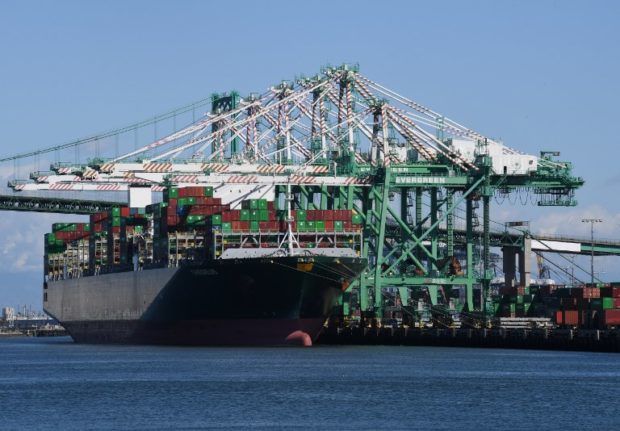Trump says US-China trade talks ‘going very well’

In this file photo taken on February 16, 2019, shipping containers from China and other nations are unloaded at the Long Beach Port in Los Angeles, California. US-China trade talks aimed at ending a damaging tariff war resumed on February 19, 2019, in Washington, the White House said. The last set of talks ended Friday in Beijing with no deal, though US President Donald Trump said discussions were going “extremely well” and suggested he could extend a March 1 truce deadline for an agreement to be reached. AFP
WASHINGTON, United States – President Donald Trump said Tuesday that trade talks with China are complex but are “going very well” and again indicated the March 1 deadline for raising tariffs could be extended.
Officials on Tuesday resumed the high-stakes negotiations aimed at ending a damaging tariff war between the economic superpowers.
“I think the talks are going very well,” Trump said on the sidelines of an event at the White House. But he called the discussions “very complex.”
After the third round of talks ended Friday in Beijing with no deal, Trump suggested he could extend a March 1 truce deadline for an agreement to be reached.
If he does not extend the timeframe, the US is set to more than double punitive import tariffs on $200 billion in Chinese goods.
Article continues after this advertisement“I can’t tell you exactly about timing. The date is not a magical date because a lot of things are happening,” Trump told reporters. “We’ll see what happens.”
Article continues after this advertisementThat comment cheered investors and sent US stock prices higher, boosting confidence the conflict could worsen.
Senior officials were due to hold another round of talks Thursday and Friday, but deputy level meetings got underway Tuesday.
On Friday, Trump had reiterated he might be willing to hold off on increasing tariffs to 25 percent from the current 10 percent on March 1 on $200 billion in Chinese goods if Washington and Beijing were close to finalizing an agreement to deal with US allegations of unfair trade and theft of American technology.
American officials accuse Beijing of seeking global industrial dominance through an array of unfair trade practices, including the alleged theft of American intellectual property, and Washington has demanded a reduction in the US trade deficit with China.
Structural changes needed
The talks are aimed at “achieving needed structural changes in China that affect trade between the United States and China,” the White House said Monday.
Bloomberg reported Tuesday that the White House also is seeking a commitment from China to keep its currency from depreciating against the US dollar, which would counteract the impact of the tariffs.
Citing two people familiar with the negotiations, the report said the currency issue has been discussed multiple times and the United States could use even higher tariffs to respond to a weakening of the yuan.
Robin Brooks, chief economist at the Institute for International Finance, a global banking organization, said the six percent decline of the yuan — also known as the renminbi or RMB — against the dollar counteracted the impact of the two rounds of US tariffs on a total of $250 billion in Chinese goods.
Brooks told AFP that “the RMB is still undervalued significantly.”
However, the currency has recovered since the low point of October 31, which indicates markets are expecting an agreement that would roll back the tariffs significantly — a view he called “too optimistic.”
Beijing and Washington have imposed duties on more than $360 billion in two-way trade, which is weighing on their manufacturing sectors and has shaken global financial markets.
Brooks said Chinese companies also have cut prices to try to prevent sales to the United States from eroding too far, which is hurting their bottom line and means that country is paying an economic price for the tariff war.
Since the December detente, China has resumed purchases of some US soybeans and dangled massive buying of American commodities to get US trade negotiators closer to a deal.
US Trade Representative Robert Lighthizer will lead the American delegation, which includes Treasury Secretary Steven Mnuchin, Commerce Secretary Wilbur Ross, economic policy advisor Larry Kudlow and trade advisor Peter Navarro, the White House said in a statement.
“The two sides will also discuss China’s pledge to purchase a substantial amount of goods and services from the United States.”
China’s Commerce Ministry said its delegation will be led by Vice Premier Liu He, who is Beijing’s top trade negotiator and key aide to President Xi Jinping, who agreed to a trade war truce with Trump at a meeting in Buenos Aires in December.
“We hope China and the US will both work hard together to implement the important consensus reached by our two heads of state in Argentina, get down to work, and walk together in the same direction towards a mutually acceptable and mutually beneficial agreement,” Foreign Ministry spokesman Geng Shuang told reporters on Tuesday. /cbb